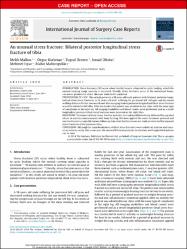| dc.contributor.author | Malkoç, Melih | |
| dc.contributor.author | Korkmaz, Özgür | |
| dc.contributor.author | Örmeci, Tuğrul | |
| dc.contributor.author | Oltulu, İsmail | |
| dc.contributor.author | İşyar, Mehmet | |
| dc.contributor.author | Mahiroğulları, Mahir | |
| dc.date.accessioned | 10.07.201910:49:13 | |
| dc.date.accessioned | 2019-07-10T19:37:09Z | |
| dc.date.available | 10.07.201910:49:14 | |
| dc.date.available | 2019-07-10T19:37:09Z | |
| dc.date.issued | 2014 | en_US |
| dc.identifier.citation | Malko., M., Korkmaz, Ö., Örmeci, T., Oltulu, İ., İşyar, M. ve Mahiroğulları, M. (2014). An unusual stress fracture: Bilateral posterior longitudinal stress fracture of tibia. International Journal of Surgery Case Reports, 5(8), 500-504. https://dx.doi.org/10.1016/j.ijscr.2014.06.002 | en_US |
| dc.identifier.issn | 2210-2612 | |
| dc.identifier.uri | https://hdl.handle.net/20.500.12511/1341 | |
| dc.identifier.uri | https://dx.doi.org/10.1016/j.ijscr.2014.06.002 | |
| dc.description.abstract | Introduction Stress fractures (SF) occur when healthy bone is subjected to cyclic loading, which the normal carrying range capacity is exceeded. Usually, stress fractures occur at the metatarsal bones, calcaneus, proximal or distal tibia and tends to be unilateral. Presentation OF CASE This article presents a 58-year-old male patient with bilateral posterior longitudinal tibial stress fractures. A 58 years old male suffering for persistent left calf pain and decreased walking distance for last one month and after imaging studies posterior longitudinal tibial stress fracture was detected on his left tibia. After six months the patient was admitted to our clinic with the same type of complaints in his right leg. All imaging modalities and blood counts were performed and as a result longitudinal posterior tibial stress fractures were detected on his right tibia. Discussion Treatment of tibial stress fracture includes rest and modified activity, followed by a graded return to activity commensurate with bony healing. We have applied the same treatment protocol and our results were acceptable but our follow up time short for this reason our study is restricted for separate stress fractures of the posterior tibia. Conclusion Although the main localization of tibial stress fractures were unilateral, anterior and transverse pattern, rarely, like in our case, the unusual bilateral posterior localization and longitudinal pattern can be seen. | en_US |
| dc.language.iso | eng | en_US |
| dc.publisher | Elsevier | en_US |
| dc.rights | info:eu-repo/semantics/openAccess | en_US |
| dc.rights | Attribution-NonCommercial-NoDerivs 3.0 Unported | * |
| dc.rights.uri | https://creativecommons.org/licenses/by-nc-nd/3.0/ | * |
| dc.subject | Longitudinal Tibial Fracture | en_US |
| dc.subject | Tibial Stress Fracture | en_US |
| dc.title | An unusual stress fracture: Bilateral posterior longitudinal stress fracture of tibia | en_US |
| dc.type | article | en_US |
| dc.relation.ispartof | International Journal of Surgery Case Reports | en_US |
| dc.department | İstanbul Medipol Üniversitesi, Tıp Fakültesi, Cerrahi Tıp Bilimleri Bölümü, Ortopedi ve Travmatoloji Ana Bilim Dalı | en_US |
| dc.department | İstanbul Medipol Üniversitesi, Tıp Fakültesi, Dahili Tıp Bilimleri Bölümü, Radyoloji Ana Bilim Dalı | en_US |
| dc.authorid | 0000-0002-4843-5121 | en_US |
| dc.authorid | 0000-0001-8532-4917 | en_US |
| dc.authorid | 0000-0001-9716-7795 | en_US |
| dc.authorid | 0000-0001-9052-4411 | en_US |
| dc.identifier.volume | 5 | en_US |
| dc.identifier.issue | 8 | en_US |
| dc.identifier.startpage | 500 | en_US |
| dc.identifier.endpage | 504 | en_US |
| dc.relation.publicationcategory | Makale - Uluslararası Hakemli Dergi - Kurum Öğretim Elemanı | en_US |
| dc.identifier.doi | 10.1016/j.ijscr.2014.06.002 | en_US |
| dc.identifier.scopusquality | Q3 | en_US |



















